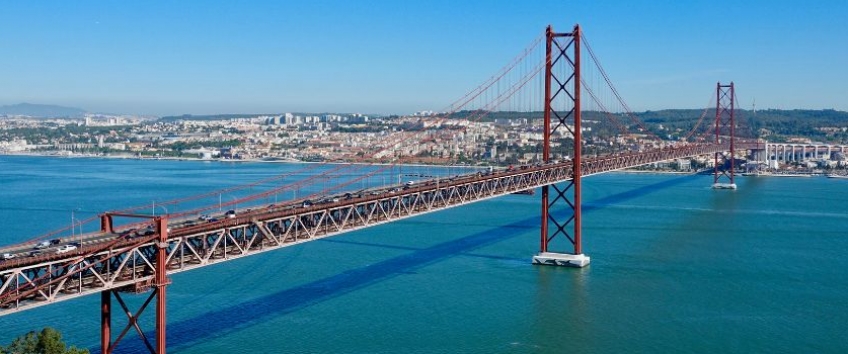Pathways of prosperity, the rivers in Portugal are flowing symbols of sustainability
Have you ever wondered how important rivers are in our lives? Not only they were a big part of our development as a society and as a source of drinking water, rivers are also a part of many of our happy memories. In today's article, we share some facts about the main rivers in Portugal. It’s always nice to learn something new, right?
The main Rivers in Portugal
Portugal boasts several significant rivers that play crucial roles in the country's geography, history, and ecology. We’ll be focusing on the most important ones and get to know their characteristics. These rivers not only contribute to Portugal's economic activities such as agriculture and tourism but also hold cultural significance, reflecting the country's rich heritage and natural beauty. Let’s get to know them better?
Tagus River
Tagus River (Tejo River or, in Portuguese, Rio Tejo) is the biggest river in Portugal and one of the biggest of the Iberian Peninsula, with around 1100 km. It starts in Spain, in the Albarracin mountains. It gracefully meanders through both Spain and Portugal before flowing into the Atlantic Ocean.
The river basin, covering substantial portions of the Iberian Peninsula, encompasses major urban centers such as Madrid and Lisbon, the capital cities of Spain and Portugal, respectively. It’s one of the most important rivers in Portugal and Spain.
Dotted along the Tagus are strategically placed dams, constructed for purposes ranging from hydroelectric power generation to water supply. Beyond its infrastructural significance, the Tagus River Portugal has played a pivotal role in the historical narratives of Spain and Portugal, functioning as a vital conduit for trade and transportation.
Numerous bridges also span the River Tagus Portugal, connecting cities and regions on both sides. In Lisbon, the Tagus estuary is crossed by two bridges: 25 de Abril Bridge, one of the biggest suspension bridges of the world and Vasco da Gama Bridge, with around 17 km of length (the largest bridge in the European Union).
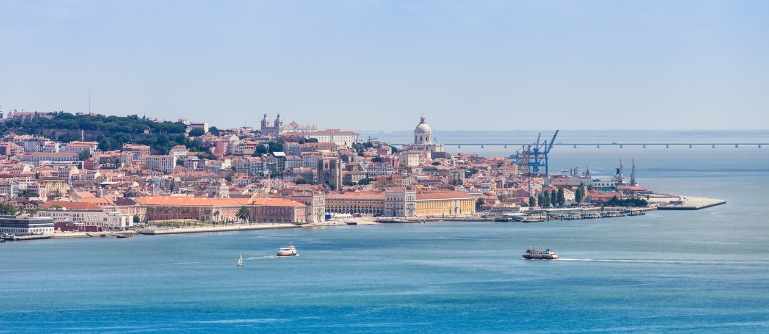 Tagus River is one of the most important rivers in Spain and Portugal
Tagus River is one of the most important rivers in Spain and PortugalNavigation on the Tagus has been integral throughout history. Even today, the river remains navigable in certain sections, supporting both commercial activities and recreational boating. In essence, the Tagus River weaves together geography, ecology, and cultural heritage, embodying the rich tapestry of the Iberian Peninsula.
Tagus River during the Portuguese Age of Discovery
The Age of Discovery was a series of maritime expeditions undertaken by the Portuguese to explore new trade routes to the East and expand Portuguese influence worldwide.
The Tagus River played a crucial role during that period. Some of the most famous expeditions, led by explorers such as Vasco da Gama and Fernão Mendes Pinto, set sail from Lisbon and navigated the Tagus River before reaching the open oceans.
Lisbon served as the starting point for many Portuguese maritime expeditions. The city became a significant center for planning, preparation, and departure for voyages around the world. The estuary of the Tagus River provided an ideal location for the construction of ports and docks, facilitating the embarkation and disembarkation of vessels.
The Tagus River contributed to the establishment of maritime routes and the success of expeditions.
Sado River
It starts in the Alentejo region and its course is fully Portuguese. Sado runs from south to north, making it one of the most unique rivers in Portugal.
The river forms a large estuary, known as the Sado Estuary, near the town of Setúbal. This place is recognized for its ecological importance and biodiversity. It has been classified as a Natural Reserve for more than 30 years, where we can watch hundreds of fish, birds and Bottlenose dolphins, the only community in Portugal and one of the few in Europe.
Overall, the Sado River and its estuary contribute to the natural beauty and ecological richness of the region, making it a notable area for both locals and visitors to explore.
Mondego River
The Mondego River is another significant river in Portugal, located entirely within Portugal. It is also the only Portuguese river that starts in a street-side fountain. The Mondego River originates at an altitude of 1425 meters, gradually gaining strength and becoming the largest river in Portugal.
It flows from the Serra da Estrela mountain range in the central part of the country and empties into the Atlantic Ocean near the city of Figueira da Foz.
Nearby Figueira da Foz, the river is a great place for birdwatching, where you can see flamingos and herons, for example. The Mondego River and its surrounding areas are known for their ecological diversity and natural beauty. It is an important feature of the central region of Portugal.
Guadiana River
The Guadiana River flows through both Spain and Portugal. It has played a role in the history and development of the regions it traverses. It has been an important waterway for transportation and trade over the centuries, just like the Tagus river in Portugal.
It starts in Spain and runs into Vila Real de Santo António, Algarve. Here, the river turns into a waterfall 20 meters height, “Pulo de Lobo”, creating an amazing scene. You can also find the biggest artificial lake in Europe here, the Alqueva Dam.
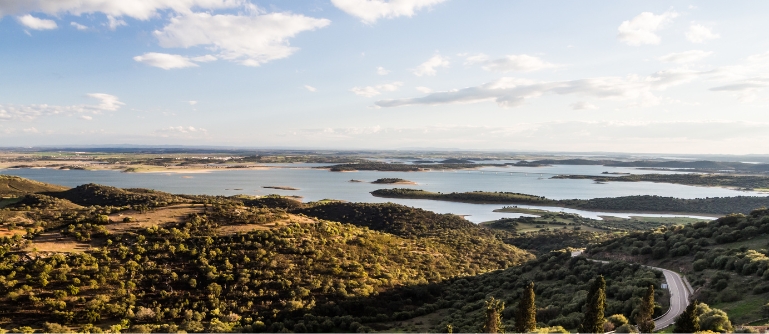 Portugal rivers: Alqueva is one of the largest artificial lakes in Europe, created by the damming of the river
Portugal rivers: Alqueva is one of the largest artificial lakes in Europe, created by the damming of the river
Minho River
The Minho River is approximately 315 km long. It forms part of the natural border between Portugal and Spain, separating the Portuguese region of Minho from the Spanish region of Galicia. The river originates in the Serra de Meira in the Spanish province of Lugo and flows westward, eventually reaching the Atlantic Ocean.
Its surrounding areas are characterized by diverse flora and fauna. The river is home to various fish species, including trout and lampreys. The estuary of the Minho River is an important habitat for bird species.
The Minho River is popular for water sports such as kayaking, rafting, and canoeing. The river's currents and rapids provide opportunities for adventure enthusiasts.
Douro River
With about 900 km of length, Douro (often referred to as the "Rio Douro" in Portuguese) is the third biggest river in the Iberian Peninsula. It starts at Serra de Urbión, Spain and goes into Porto before reaching the Atlantic Ocean.
The Douro River is a popular destination for river cruises, offering travelers the opportunity to experience the scenic beauty of the Douro Valley, visit vineyards, and explore historic towns along the riverbanks. Cruising on the Douro River until its Portuguese last stop, Barca d'Alva, is a popular and scenic journey through the Douro Valley.
It’s one of the rivers in Portugal with the most history. Let’s get to know more about Douro?
Why is it called “Douro”?
The name "Douro" is believed to have ancient origins, and its etymology is associated with Latin and Celtic influences. There are, however, two main theories that give us some clues.
On one hand, some believe that the name Douro comes from the ancient Celtic language, where “dur” or “dubr” meant water. On the other hand, there’s a tale that says that there were stones that rolled and shone in the region, that they believed were made of gold, or “ouro”, in Portuguese.
The importance of Douro
The river was classified as a World Heritage by UNESCO in 2001. And what’s its history?
Back in the day, the river was the main connecting element between the Douro region and Porto. This connection was important to take the Porto Wine to its aging process in Gaia. At the time, there weren't any railways, so the river was the only option.
It’s possible to cross over the Douro River between Porto and Vila Nova de Gaia through 6 Bridges: Luiz I, D. Maria Pia, Infante D. Henrique, Freixo, Arrábida e São João. You can also take a cruise under the bridges and get to know more about their history. More information here!
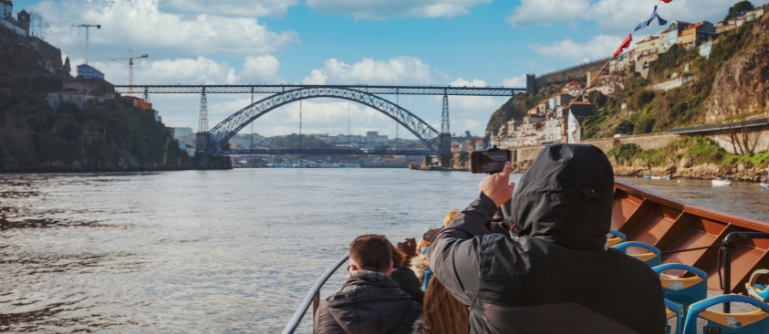 Douro Bridges Cruise: an unique experience in one of the most iconic rivers in Portugal
Douro Bridges Cruise: an unique experience in one of the most iconic rivers in Portugal
A region full of history
Its banks, made of shale, provide a microclimate perfect to produce Porto Wine. This region, with more than 2000 years of history, is also known for its beauty - it’s not by chance that the road that connects Peso da Régua to Pinhão has been considered as “the most beautiful road in the world”!
We can list many reasons to visit the Douro River and its region. Its beauty and history are definitely among them. If you are interested in knowing more about these regions, we invite you to learn about our new Lisbon to Douro Cruise. Discover the best of the Douro Valley in a 2-day all-inclusive program.
Legend of the Island of Love in the Douro River
The confluence of the Paiva and Douro rivers stands as a captivating manifestation of beauty, evoking a magical realm of distant kingdoms and noble figures: the Island of Castelo, or Island of Love (also known as Ilha dos Amores, in Portuguese).
Legend says it was created by the clandestine romance between a blue-blooded noblewoman and a humble farmer. Faced with an arranged marriage to a nobleman, the farmer, driven to despair, takes drastic measures by eliminating his rival suitor.
Seeking refuge on the deserted island, he devises a plan to abduct his beloved. Yet, a tragic storm interrupts their escape, engulfing the couple in its tumultuous waters. The legend suggests that the vengeful spirit of the nobleman triggered the tempest, christening the island as the Island of Loves.
Nowadays, this small island in the middle of the Douro River continues to serve as the backdrop for romantic tales, even hosting wedding ceremonies. You can see the Island if you take one of our Douro River Cruises to the Douro Valley.
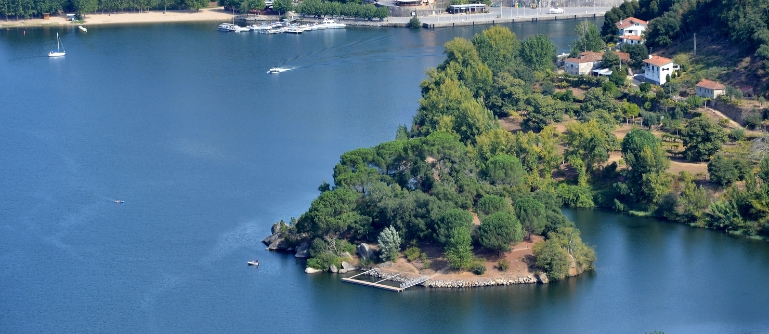 Island of Love: a hidden treasure in the Douro River
Island of Love: a hidden treasure in the Douro RiverRivers in Portugal are symbols of life, connecting past, present, and future
Portugal offers an infinite variety of landscapes and cultures. From the northernmost reaches to the southernmost expanses, the chances of discovering awe-inspiring places in the rivers of Portugal are boundless.
We should always seek every opportunity to get to know more about our amazing world. If you’re looking for the right Douro River Cruise for you, explore our website and find your next unforgettable experience. See you soon!

